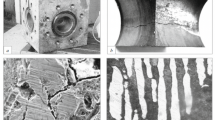Abstract
This paper describes a numerical analysis which relates the sulphur content of structural steel and hydrogen induced cracking in welded-joints. Transient hydrogen concentration and hydrostatic pressure at the joint were calculated based on a mathematical model.
The study indicates that, to reduce the possibility of cracking, both hydrogen and sulphur contents should preferrably be kept minimal. If considerably high hydrogen input of electrodes (greater than 15 cc/100 gm dep. metal) is unavoidable, then materials with sulphur content less than 0.010% should not be used.
Résumé
Le mémoire décrit une analyse numérique relative à la teneur en soufre d'un acier de construction et à la fissuration due à l'hydrogène dans les joints soudés. On a calculé la concentration en hydrogène transitoire et la pression hydrostatique dans la soudure en se basant sur un modèle mathématique.
L'étude indique que si l'on veut réduire la possibilité de fissuration, les teneurs en hydrogène et en soufre devraient être aussi basses que possible. Si des quantités importantes d'hydrogène sont introduites par les électrodes (supérieures à 15 cm 3/100 gr de métal déposé), et inévitables, des matériaux avec des teneurs en soufre inférieures à 0,010% ne devraient pas être utilisées.
Similar content being viewed by others
References
A. Granstrom and G. Alpsten, Properties of Steel Products Loaded at Right Angles to the Rolling Plane—A Literature Survey. Swedish Institute of Steel Construction, Report 15:1 (June 1970).
W. Schönherr, Metal Construction and British Welding Journal, 6, (2) (1974) 56–61.
E. Betz and H.K. Leung, On the Lamellar Tearing in Welded Steel Structures—The State of the Art. Engineering Bulletin ME29, Newcastle University, Australia (August 1978).
E.O. Hall, Yield Point Phenomena in Metals and Alloys. MacMillan Co. Ltd. (1970).
C.St. John and W.W. Gerberich, Metallurgical Transactions, 4, (1973) 589–594.
H.K. Leung, Lamellar Tearing and Related Problems. Ph.D. Thesis, Newcastle University, Australia (March 1978).
E.W. Johnson and M.L. Hill, Transaction of Metallurgical Society of AIME, 218 (December 1960) 1104–1112.
C. Sykes, H.H. Burton and C.C. Gegg, Iron and Steel Institute, Journal, 156 (June 1947) 155–180.
W. Geller and T.H. Sun, Arch. Eisenhüttenw, 21 (1950) 423.
W. Kauzmann, Thermal Properties of Matter, Volume I—Kinetic Theory of Gases. W.A. Benjamin, Inc., New York (1966) 74.
D.M. Allen-Booth, C. Atkinson and B.A. Bilby, Acta Metallurgica, 23 (March 1975) 371–376.
J.E. Croll, Factors Inffluencing the Through-Thickness Ductility of Structural Steels. BHP Technical Bulletin, 20, (1) (1976) 24–29.
G.J. Spaeder, Welding Research Supplement, the Welding Journal, 54, (6) (1975) 196s-200s.
S. Kanazawa, K. Kawamura, K. Yamato, T. Haze, T. Inoue, T. Nuibe and T. Fukuda, Lamellar Tearing Resting Steels and the Direction for Use of Them. International Institute of Welding Document IIX-873–74 (April 1974).
J.C.M. Farrar, The Relationship between Metallurgical Factors and Susceptibility to Lamellar Tearing. Welding Institute Report 3298/20/73 (1973) 39.
I.D. Simpson, L. Dyer and J.K. MacDonald, Effect of the Shape and Size of Inclusions on Through-Thickness Properties. BHP Technical Bulletin, 20, (1) (1976) 30–36.
Author information
Authors and Affiliations
Rights and permissions
About this article
Cite this article
Betz, E., Leung, H.K. The effect of sulphur content in hydrogen induced cracking of steel weldment. Int J Fract 16, 317–325 (1980). https://doi.org/10.1007/BF00018235
Received:
Issue Date:
DOI: https://doi.org/10.1007/BF00018235




